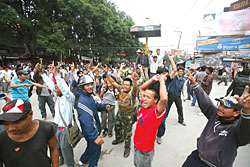 KIRAN PANDAY |
Perhaps that's the reason the overclass has not taken the challenge of the Maoists too seriously. Unlike the panicky NGO-entrepreneurs, the bankers and builders appear to believe that Baburam Bhattarai is no different from Mahesh Acharya or Bharat Mohan Adhikari. This complacence of the rich is confusing the middle class no end.
The class base of Nepal's political parties has never been very clear. However, a rough generalisation was still possible until the mid-nineties. Following the first Jana Andolan, the upper class retained its loyalty to Panchayat-era politicos. Independent professionals and the self-employed gravitated towards the Nepali Congress. The NCP (UML) emerged as the bastion of the petty bourgeoisie. In European terms, these three groupings formed the conservatives, the social democrats and the Hindu democrats of the Nepali polity. Since there was no political force that represented the peasants or the working class, they simply traded their loyalties whenever and wherever they could.
Enter a group of wily political entrepreneurs, who mobilised the unorganised and carefully presented themselves as a credible challenger to all existing forces. For the royalists, this new formation was republican. For the NC's free market fundamentalists, they were reinvented communists. And for the hubristic Brahminists of the UML, these new politicos who organised the outcastes, untouchables and the marginalised were a challenge that undermined their standing at the very core. The Maoist brand name helped - nothing galvanises the underclass as strongly as the idea of getting back violently at their real or perceived oppressors. But it was such an incendiary mix of ideas that the resulting wildfire soon careered out of control. The middle class watched in fascination until the heat of the insurgency became unbearable.
It was the very composition of the Maoist party base that most frightened the insecure middle class. Maoist enforcers were neither peasants nor workers but belonged to a group that Marx called the lumpenproletariat - those renegades of society who often turned out to be "bribed tools of reactionary intrigue". The Maoist people's carnival last week was a mammoth public relations exercise to reassure the Kathmandu bourgeoisie that there was no need to fear a party whose chairman was willing to boogie in public with a Nepali actress. Unfortunately for the Maoists, the charade turned out to be completely counterproductive.
Over half of Kathmandu Valley's three million residents are well off by Nepali standards. In emerging societies, prosperity doesn't come cheap; in fact it often extracts a very heavy emotional, moral and physical price. The protestors that the Maoists paraded around Singha Darbar last week gave the aspiring class of the capital city a glimpse of their own past. No wonder the motorcyclists looked so terrified. The sight of tens of thousands of upstarts singing and dancing, ostensibly to grab their hard-earned comforts, must have been pretty unnerving.
The upper class of yesteryear had at least a vague notion of noblesse oblige and rid itself of its guilty conscience through favouritism, acts of kindness towards those who could come in handy in times of trouble. For the overclass, everything has a price and everybody is for sale, including the Maoists. Meanwhile, the underclass has little to lose and looks up to the Maoists with expectant eyes. So what if Comrade Chairman lives in a fortress? Even in a Dalit village of straw huts, local deities have to be housed inside a brick house.
But for the aspiring class that has earned its present level of prosperity by treating greed as god, the Maoists have little to offer except assurances. The future of the UCPN (Maoist) ultimately depends on how it can win over the terrified middle strata of Nepali society.


